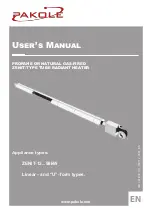
Propane gas and natural gas has man-made odorant added specifically for detection of fuel gas leaks.
If a gas leak occurs, you should be able to smell the fuel gas.
THAT’S YOUR SIGNAL TO GO INTO IMMEDIATE ACTION!
■
Do not take any action that could ignite the fuel gas. Do
not operate any electrical switches. Do not pull any
power supply or extension cords. Do not light matches
o r a ny ot h e r s o u rc e o f f l a m e . D o n ot u s e yo u r
telephone.
■
Get everyone out of the building and away from the area
immediately.
■
Close all propane (LP) gas tank or cylinder fuel supply
valves, or the main fuel supply valve at the meter if you
use natural gas.
■
Propane gas is heavier than air and may settle in low
areas. When you have reason to suspect a propane
leak, keep out of all low areas.
■
Natural gas is lighter than air and can collect around
rafters or ceilings.
■
Use your neighbor’s phone and call your fuel gas
supplier and your fire department. Do not re-enter the
building or area.
■
Stay out of the building and away from the area until
declared safe by the firefighters and your fuel gas
supplier.
■
FINALLY,
let the fuel gas ser vice person and the
firefighters check for escaped gas. Have them air out
the building and area before you return. Properly
trained service people must repair the leak, check for
further leakages, and then relight the heater for you.
■
Some people cannot smell well. Some people cannot
smell the odor of the man-made chemical added to
propane or natural gas. You must determine if you
can smell the odorant in this fuel gas.
■
Learn to recognize the odor of propane gas or natural
gas. Local propane gas dealers will be more than
happy to give you a “scratch and sniff” pamphlet. Use it
to become familiar with the fuel gas odor.
■
Smoking can decrease your ability to smell. Being
around an odor for a period of time can affect your
sensitivity to that particular odor. Odors present in
animal confinement buildings can mask fuel gas odor.
■
The odorant in propane gas and natural gas is
colorless and the intensity of its odor can fade under
some circumstances.
■
If there is an underground leak, the movement of gas
through the soil can filter the odorant.
■
Propane gas odor may differ in intensity at different
levels. Since propane gas is heavier than air, there may
be more odor at lower levels.
■
Always be sensitive to the slightest gas odor.
If you
continue to detect any gas odor, no matter how small,
treat it as a serious leak. Immediately go into action as
discussed previously.
FUEL GAS ODOR
ODOR FADING -- NO ODOR DETECTED
ATTENTION -- CRITICAL POINTS TO REMEMBER!
■
Propane gas and natural gas has a distinctive odor.
Learn to recognize this odors. (Reference “Fuel Gas
Odor” and “Odor Fading” sections above.
■
If you have not been properly trained in repair and service
of propane gas and natural gas fueled heaters, then do
not attempt to light the heater, perform service or repairs,
or make any adjustments to the heater on a propane gas
or fuel system.
■
Even if you are not properly trained in the service and
repair of radiant heaters, ALWAYS be consciously aware
of the odors of propane gas and natural gas.
■
A periodic “sniff test” around the heater or at the
heater’s joints; i.e. hose, connections, etc., is a good
safety practice under any conditions. If you smell even
a small amount of gas, CONTACT YOUR FUEL GAS
SUPPLIER IMMEDIATELY. DO NOT WAIT!
6
WARNING
■
Do not use this radiant heater for heating human living
quarters.
■
Do not use in unventilated areas.
■
The flow of combustion and ventilation air must not be
obstructed.
■
Proper ventilation must be provided to support the
combustion air requirements of the heater being used.
■
Refer to the specification section of the Owner’s
M a n u a l , h e a te r ’ s d a t a p l a te , o r c o n t a c t t h e
L.B. White Company to determine combustion air
ventilation requirements of the heater.
■
Lack of proper ventilation air will lead to carbon
monoxide poisoning in humans leading to serious
injur y or death. Symptoms of carbon monoxide
poisoning can include headaches, dizziness and
difficulty in breathing.
■
Symptoms of improper ventilation affecting livestock
can be disease, lower feed conversion, or death.
Asphyxiation Hazard
Safety Precautions







































